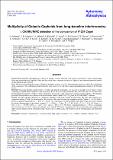Multiplicity of Galactic Cepheids from long-baseline interferometry I. CHARA/MIRC detection of the companion of V1334 Cygni
Abstract
Context. More than 60% of Cepheids are in binary or multiple systems. Studying such systems could lead to a better understanding of the age and evolution of Cepheids. These are also useful tools to estimate the mass of Cepheids, and constrain theoretical models of their pulsation and evolution. Aims. We aim at determining the masses of Cepheids in binary systems, as well as their geometric distances and the flux contribution of the companions. The combination of interferometry with spectroscopy will off er a unique and independent estimate of the Cepheid masses. Methods. Using long-baseline interferometry at visible and infrared wavelengths, it is possible to spatially resolve binary systems containing a Cepheid down to milliarcsecond separations. Based on the resulting visual orbit and radial velocities, we can then derive the fundamental parameters of these systems, particularly the masses of the components and the geometric distance. We therefore performed interferometric observations of the first-overtone mode Cepheid V1334 Cyg with the CHARA/MIRC combiner. Results. We report the first detection of a Cepheid companion using long-baseline interferometry. We detect the signature of a companion orbiting V1334 Cyg at two epochs. We measure a flux ratio between the companion and the Cepheid f = 3.10 ± 0.08%, giving an apparent magnitude mH = 8.47 ± 0.15 mag. The combination of interferometric and spectroscopic data have enabled the unique determination of the orbital elements. P = 1938.6 ± 1.2 days, Tp = 2 443 616.1 ± 7.3, a = 8.54 ± 0.51 mas, i = 124.7 ± 1.8°, e = 0.190 ± 0.013, ω = 228.7 ± 1.6°, and Ω = 206.3 ± 9.4°. We derive a minimal distance d ~ 691 pc, a minimum mass for both stars of 3.6 M⊙, with a spectral type earlier than B5.5V for the companion star. Our measured flux ratio suggests that radial velocity detection of the companion using spectroscopy is within reach, and would provide an orbital parallax and model-free masses.
Citation
Gallenne , A , Monnier , J D , Merand , A , Kervella , P , Kraus , S , Schaefer , G H , Gieren , W , Pietrzynski , G , Szabados , L , Che , X , Baron , F , Pedretti , E , McAlister , H , ten Brummelaar , T , Sturmann , J , Sturmann , L , Turner , N , Farrington , C & Vargas , N 2013 , ' Multiplicity of Galactic Cepheids from long-baseline interferometry I. CHARA/MIRC detection of the companion of V1334 Cygni ' , Astronomy & Astrophysics , vol. 552 , A21 . https://doi.org/10.1051/0004-6361/201321091
Publication
Astronomy & Astrophysics
Status
Peer reviewed
ISSN
0004-6361Type
Journal article
Description
W.G. and G.P. acknowledge financial support for this work from the BASAL Centro de Astrofísica y Tecnologías Afines (CATA) PFB-06/2007. Support from the Polish National Science Centre grant MAESTRO and the Polish Ministry of Science grant Ideas Plus (awarded to G. P.) is also acknowledge. This research received the support of PHASE, the high angular resolution partnership between ONERA, Observatoire de Paris, CNRS, and University Denis Diderot Paris 7. A.G. acknowledges support from FONDECYT grant 3130361. LSz has been supported by the ESTEC Contract No.4000106398/12/NL/KML.Collections
Items in the St Andrews Research Repository are protected by copyright, with all rights reserved, unless otherwise indicated.

